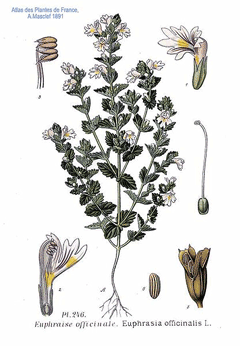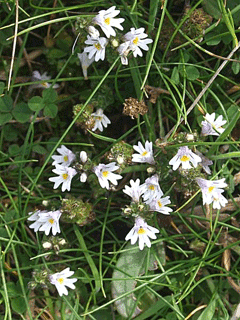 |
|
http://commons.wikimedia.org/wiki/File:246_Euphrasia_officinalis_L.jpg |
 |
| http://www.geograph.org.uk/profile/139 |
Translate this page:
Summary
Physical Characteristics

 Euphrasia officinalis is a ANNUAL growing to 0.2 m (0ft 8in) by 0.1 m (0ft 4in).
Euphrasia officinalis is a ANNUAL growing to 0.2 m (0ft 8in) by 0.1 m (0ft 4in).
See above for USDA hardiness. It is hardy to UK zone 6. It is in flower from July to September. The species is hermaphrodite (has both male and female organs) and is pollinated by Bees. The plant is self-fertile.
Suitable for: light (sandy), medium (loamy) and heavy (clay) soils. Suitable pH: mildly acid, neutral and basic (mildly alkaline) soils and can grow in very alkaline soils.
It can grow in semi-shade (light woodland) or no shade. It prefers moist soil.
UK Hardiness Map
US Hardiness Map
Synonyms
Bartsia imbricata
Plant Habitats
Lawn; Meadow;
Edible Uses
Edible Parts: Leaves
Edible Uses:
Leaves - raw[7]. They are occasionally used in salads for their slightly bitter flavour[7].
References More on Edible Uses
Medicinal Uses
Plants For A Future can not take any responsibility for any adverse effects from the use of plants. Always seek advice from a professional before using a plant medicinally.
Antiinflammatory Astringent Digestive Homeopathy Ophthalmic Tonic
Eyebright has a long history of herbal use in the treatment of eye problems and is still in current herbal use[4]. It is important that only the correct forms of eyebright, with glandular hairs on the calyx, are used, since other forms do not possess medicinal virtues[268]. Eyebright tightens the mucous membranes of the eye and appears to relieve the inflammation of conjunctivitis and blepharitis[254]. Its ability to counter catarrh means that it is often used for infectious and allergic conditions affecting the eyes, middle ear, sinuses and nasal passages[254]. The whole plant is anti-inflammatory, astringent, digestive, ophthalmic and slightly tonic[[4, 7, 9, 14, 165, 220]. It is taken internally in the treatment of catarrh, sinusitis, hay fever, upper respiratory tract infections etc[238]. As an ophthalmic, an infusion of the plant can be taken internally or used as an eye wash. Alternatively, the diluted juice can be dropped into the eyes[232]. Some caution should be exercised, experimentally it can induce side effects including dim vision[222]. The plant's astringency makes it inappropriate for treating dry or stuffy congestion[254]. The plant can be used externally as a poultice to aid the healing of wounds[268]. Eyebright should be harvested when in flower and can be dried for later use[238]. The dried herb is a ingredient of herbal smoking mixtures, used in the treatment of chronic bronchial colds[4]. A homeopathic remedy is made from the expressed juice of the plant[232]. It is used particularly in the treatment of eye inflammations and colds[7, 232].
References More on Medicinal Uses
The Bookshop: Edible Plant Books
Our Latest books on Perennial Plants For Food Forests and Permaculture Gardens in paperback or digital formats.

Edible Tropical Plants
Food Forest Plants for Hotter Conditions: 250+ Plants For Tropical Food Forests & Permaculture Gardens.
More

Edible Temperate Plants
Plants for Your Food Forest: 500 Plants for Temperate Food Forests & Permaculture Gardens.
More

More Books
PFAF have eight books available in paperback and digital formats. Browse the shop for more information.
Shop Now
Other Uses
References More on Other Uses
Cultivation details
Succeeds in most soils, preferring chalk or limestone[200]. Eyebright is a semi-parasitic plant, growing on the roots of various species of grass[4] and also on Trifolium pratense and Plantago species[238]. The grass does not seem to suffer unduly from this parasitism since eyebright is an annual and its cells do not penetrate very deeply into the grass[4]. There is some doubt over the validity of the name of this species, some botanists now call it Euphrasia rostkoviana. Eyebright is a variable aggregate species, some botanists divide it into a number of different species[1, 50]. Only those forms of eyebright which have glandular hairs on the calyx possess medicinal qualities[268]. It hybridizes freely with other members of this genus[200].
References Carbon Farming Information and Carbon Sequestration Information
Temperature Converter
Type a value in the Celsius field to convert the value to Fahrenheit:
Fahrenheit:
The PFAF Bookshop
Plants For A Future have a number of books available in paperback and digital form. Book titles include Edible Plants, Edible Perennials, Edible Trees,Edible Shrubs, Woodland Gardening, and Temperate Food Forest Plants. Our new book is Food Forest Plants For Hotter Conditions (Tropical and Sub-Tropical).
Shop Now
Plant Propagation
Sow the seed outdoors in situ in early spring amongst grass in a moist but not marshy soil[1].
Other Names
If available other names are mentioned here
Native Range
TEMPERATE ASIA: Turkey (northeast), Georgia EUROPE: Denmark, Finland, United Kingdom, Ireland, Sweden, Austria, Belgium, Switzerland, Czech Republic, Germany, Hungary, Netherlands, Poland, Slovakia, Russian Federation (European part), Belarus, Estonia, Lithuania, Latvia, Ukraine, Albania, Bulgaria, Bosnia and Herzegovina, Croatia, Italy, Romania, Serbia, Slovenia, Spain, France
Weed Potential
Right plant wrong place. We are currently updating this section.
Please note that a plant may be invasive in one area but may not in your area so it's worth checking.
Conservation Status
IUCN Red List of Threatened Plants Status :

Growth: S = slow M = medium F = fast. Soil: L = light (sandy) M = medium H = heavy (clay). pH: A = acid N = neutral B = basic (alkaline). Shade: F = full shade S = semi-shade N = no shade. Moisture: D = dry M = Moist We = wet Wa = water.
Now available:
Food Forest Plants for Mediterranean Conditions
350+ Perennial Plants For Mediterranean and Drier Food Forests and Permaculture Gardens.
[Paperback and eBook]
This is the third in Plants For A Future's series of plant guides for food forests tailored to
specific climate zones. Following volumes on temperate and tropical ecosystems, this book focuses
on species suited to Mediterranean conditions—regions with hot, dry summers and cool, wet winters,
often facing the added challenge of climate change.
Read More
Expert comment
Author
L.
Botanical References
17200
Links / References
For a list of references used on this page please go here
Readers comment
| Add a comment |
|
If you have important information about this plant that may help other users please add a comment or link below. Only comments or links that are felt to be directly relevant to a plant will be included. If you think a comment/link or information contained on this page is inaccurate or misleading we would welcome your feedback at [email protected]. If you have questions about a plant please use the Forum on this website as we do not have the resources to answer questions ourselves.
* Please note: the comments by website users are not necessarily those held by PFAF and may give misleading or inaccurate information.
To leave a comment please Register or login here All comments need to be approved so will not appear immediately.
|
Subject : Euphrasia officinalis
|
|
|
|